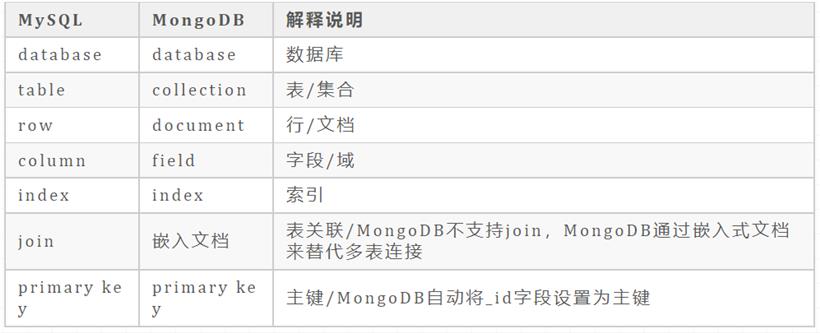- 联系我们
- duidaima.com 版权声明
- 闽ICP备2020021581号
-
 闽公网安备 35020302035485号
闽公网安备 35020302035485号
 闽公网安备 35020302035485号
闽公网安备 35020302035485号
可扩展性:MongoDB可以轻松地扩展到多个节点,以处理大量数据和高并发请求。
MongoDB的缺点:
不支持事务:MongoDB在早期版本中不支持事务,虽然在最新版本中已经支持了事务,但是相比传统的关系型数据库还是有所不足。
<dependency>
<groupId>org.springframework.boot</groupId>
<artifactId>spring-boot-starter-data-mongodb</artifactId>
</dependency>
然后配置连接信息:spring.data.mongodb.host=localhost spring.data.mongodb.port=27017 spring.data.mongodb.database=mydb其中,host和port分别是MongoDB的主机名和端口号,database是要连接的数据库名称。如果MongoDB需要进行身份验证,还需要添加以下配置:
spring.data.mongodb.username=myuser spring.data.mongodb.password=mypassword其中,username和password分别是MongoDB的用户名和密码。
@Document(collection = "student")
public class Student {
@Id
private String id;
private String name;
private int age;
// 省略getter和setter方法
}
3.创建学生Repository接口。@Repository
public interface StudentRepository extends MongoRepository<Student, String> {
}
4.创建学生Service接口和实现类。public interface StudentService {
List<Student> findAll();
Student findById(String id);
void save(Student student);
void deleteById(String id);
}
// 堆代码 duidaima.com
@Service
public class StudentServiceImpl implements StudentService {
@Autowired
private StudentRepository studentRepository;
@Override
public List<Student> findAll() {
return studentRepository.findAll();
}
@Override
public Student findById(String id) {
return studentRepository.findById(id).orElse(null);
}
@Override
public void save(Student student) {
studentRepository.save(student);
}
@Override
public void deleteById(String id) {
studentRepository.deleteById(id);
}
}
5.创建学生Controller类。@RestController
@RequestMapping("/students")
public class StudentController {
@Autowired
private StudentService studentService;
@GetMapping("")
public List<Student> findAll() {
return studentService.findAll();
}
@GetMapping("/{id}")
public Student findById(@PathVariable String id) {
return studentService.findById(id);
}
@PostMapping("")
public void save(@RequestBody Student student) {
studentService.save(student);
}
@PutMapping("/{id}")
public void update(@PathVariable String id, @RequestBody Student student) {
student.setId(id);
studentService.save(student);
}
@DeleteMapping("/{id}")
public void deleteById(@PathVariable String id) {
studentService.deleteById(id);
}
}
完整代码示例:@Document(collection = "student")
public class Student {
@Id
private String id;
private String name;
private int age;
// 省略getter和setter方法
}
StudentRepository.java@Repository
public interface StudentRepository extends MongoRepository<Student, String> {
}
StudentService.javapublic interface StudentService {
List<Student> findAll();
Student findById(String id);
void save(Student student);
void deleteById(String id);
}
@Service
public class StudentServiceImpl implements StudentService {
@Autowired
private StudentRepository studentRepository;
@Override
public List<Student> findAll() {
return studentRepository.findAll();
}
@Override
public Student findById(String id) {
return studentRepository.findById(id).orElse(null);
}
@Override
public void save(Student student) {
studentRepository.save(student);
}
@Override
public void deleteById(String id) {
studentRepository.deleteById(id);
}
}
StudentController.java@RestController
@RequestMapping("/students")
public class StudentController {
@Autowired
private StudentService studentService;
@GetMapping("")
public List<Student> findAll() {
return studentService.findAll();
}
@GetMapping("/{id}")
public Student findById(@PathVariable String id) {
return studentService.findById(id);
}
@PostMapping("")
public void save(@RequestBody Student student) {
studentService.save(student);
}
@PutMapping("/{id}")
public void update(@PathVariable String id, @RequestBody Student student) {
student.setId(id);
studentService.save(student);
}
@DeleteMapping("/{id}")
public void deleteById(@PathVariable String id) {
studentService.deleteById(id);
}
}